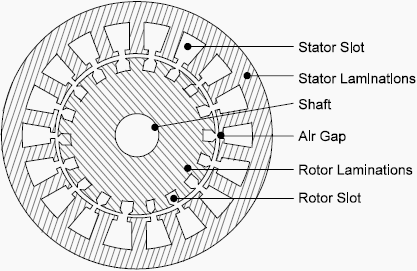
An Induction motor is also called asynchronous motor, because the speed of rotation of its rotor is less than stator. In other words, it does not run at its synchronous speed. Before going into the details of the working principal of induction motor, I wanna first summarize the basic concepts of Rotor and Stator:
Rotor
- Rotor is the rotating part of the induction motor, which is actually the shaft of the motor.
- Rotor of an Induction motor is a laminated cylindrical core.
- Moreover this laminated cylindrical core has slots that carry aluminum or copper conductors, which are joined at ends.
- So, let's now have a look at the stator of the induction motor.

Stator
- In the previous section, we have discussed the rotor details, now I am gonna throw some light on stator.
- Unlike rotor, stator is the stationary part of the induction motor.
- While rotor is a small cylindrical core which rotates in the outer cylindrical frame of the motor. This outer cylindrical frame is named as stator.
- Stator has slots to carry the winding circuit which is supplied by an AC power.
Working of Induction Motor
The working of an Induction Motor can be summarized as, “the stator winding produces magnetic field and due to electromagnetic induction a current is induced in rotor which produces torque”. No electrical connection exists between rotor and stator which differentiates it from other motors (DC, Synchronous), as it works on Faraday’s law of Electromagnetic Induction. The AC power supplied to the stator creates a magnetic field which is changing over time due to AC oscillations. This changing magnetic field produces changing magnetic flux that induces a current in rotor windings in accordance with Faraday's law. This current will generate a magnetic field to oppose the stator magnetic field in accordance with Lenz’s law. To oppose this change, the rotor will start rotating in the direction of changing magnetic field of the stator. Relative speed of the stator’s magnetic field and rotor is the driving factor. Therefore, the speed of rotor is always maintained less to keep it moving.
Poles
- Number of poles of an induction motor is denoted by “p”.
- A single phase AC machine has 2 poles of opposite polarity set at 180 degree apart.
- A simplest 3 phase machine has 6 poles which are set at 60 degree apart.
Synchronous Speed
- It is the speed of rotation of stator’s magnetic field denoted by “n_s”.
- n_s= 2f/p
Slip
- Slip is the difference between stator's magnetic field and rotor's mechanical speed of the induction motor.
- We can also say that its the difference between synchronous speed and operating speed. expressed as a ratio.
- s=(n_s-n_r)/n_s
Power Factor
- The power factor of a motor is the ratio of real power to the apparent power.
- At full load power factor of an induction motor ranges from 0.85 to 0.90 and at no load it is approx. 0.12.
Types of Induction Motors
Now lets just take a brief look on types of induction motor. Single phase and three phase are the two types of an AC Induction Motor. Single phase motors are used for smaller loads while 3 phase motors are used in high load applications.
According to the type of rotor, an induction motor is divided into two types; squirrel cage and slip ring /wound type motor. The most commonly used is the squirrel cage induction motor. Concluding, Advantage of Induction Motor is its simple operation, reliability and low cost. It is used in a number of applications in home appliances and commercial uses such as pumps, compressors, fans, mixers, conveyors, crushers, machine tools, cranes, etc.



